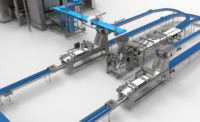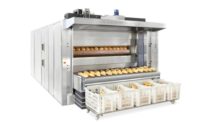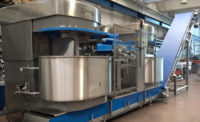Snack and bakery equipment companies have been busy updating ovens and proofers in recent months. Recently released and updated ovens have included features like greater energy savings, shorter turnaround time and wireless remote monitoring, sometimes those provided by component subcontractors. Recent updates to proofers have included updates to the equipment’s hygienic design and energy usage while working to accommodate smaller footprints.
Efficient oven technology
Koenig Bakery Systems, Ashland, VA, has developed a series of modular tunnel ovens and redesigned the Roto Passat rack oven to enable energy savings of up to 20 percent compared with its predecessor. The indirectly heated multi-deck tunnel oven MDI STRATOS mostly uses radiation for heat but also contact and natural convection. The total independence of the decks allows for management of different production rates and/or different products to be baked simultaneously. And the oven can be flexibly scaled to be made higher and/or longer at any time to suit the needs for both artisan bakeries and larger operations.
The directly fired single-deck tunnel SDD EOS oven has been custom-designed for baking flatbreads and pizzas using a series of infrared gas burners above and below the conveyor. Mainly using radiation but also contact and natural convection, the oven can reach extremely high temperatures, but also can be modulated down to 150°C (302°F). These tunnel ovens also enable automation for production steps like dough processing.
The Koenig Roto Passat SE oven, which received a 2017 American Society of Baking Eco-Design & Sustainable Technologies Innovations Award at BakingTech, uses a newly developed heater with a counterflow heat exchanger to achieve the 20 percent energy savings. This can save about 4,000 liters of heating oil, or about 12 tons of carbon dioxide, per year, based on six production days per week.
The WP RotoTherm Green rack oven from WP Bakery Group, USA, Shelton, CT, was redesigned in 2016 to make it more energy-efficient, with a better baking result and shorter turnaround time, says Bruce Gingrich, vice president, sales.
The redesigned oven has a newly developed heat exchanger with a smaller burner, using as much as 45 percent less energy. The ovens contains a set of slides called the Thermogate that blocks the air across the baking chamber when the door is opened, maintaining the heat level within 20°F and providing 66 percent faster recovery to optimal heat levels than a conventional oven, Gingrich says.
The bottom line, he says, is that three RotoTherm Green rack ovens can complete the same amount of baking as four conventional ovens, and it also takes up 20 percent less width. “We’re going to produce more out of a smaller footprint,” Gingrich says. The oven can handle about anything besides hearth-baked breads—it’s well suited for other breads, cookies, muffins and pastries.
MIWE America, Hillsborough Township, NJ, has introduced model 3.0 of its roll-in e+ oven, which is an all-purpose oven designed for baking all types of products, according to Harry Jacoby, president. In this new version, MIWE has introduced a feature that erects a “heat storage wall” when the door is opened, leading to “minimal” heat loss and much faster retention, he says.
The MIWE roll-in e+ 3.0 also offers atmospheric baking, continuously adjusting its pressure by opening and closing a damper depending on the temperature and humidity in the room, balancing the chamber with outside conditions and enabling more-efficient operation of the burner and a more-consistent baking result, Jacoby says.
Lastly, MIWE’s version 3.0 can be monitored remotely and wirelessly to see what’s happening with the current baking job, upload and download different programs, and even check historical data on the oven, Jacoby says.
Earlier this year, Erika Record Baking Equipment, Clifton, NJ, joined forces with Cindy Chananie of CINCH Baking Equipment to distribute the Italian-made Tagliavini line of artisan ovens in the U.S. The company created a line called the Rotovent geared toward the U.S. market, with three circulation fans on the back wall of the oven instead of one. Available in single- or double-rack configuration, the ovens can be purchased with electric, gas or biodiesel fuel.
The Tagliavini Rotovent also offers a SMART Digital Control Panel that handles baking temperature, baking time with an alarm, lighting and steam delivery, as well as a weekly startup program called PROSET that stores up to 10 baking programs. The oven provides easing cleaning through the front and the control panel, as well as a double-glass door for easy access to light bulbs.
Sanitary design has been high on the priority list for Kaak, Terborg, The Netherlands, as it redesigned its ovens and proofers. The company did a “total redesign” of the Thermo-Oil DAUB ovens to increase accessibility for cleaning, as well as to reduce manufacturing time, says Erik Slagman, area sales manager. The MCS tunnel oven now has fully automatic controls so that operators no longer have to push and pull the slides, dampers, valves and doors—everything is automatically adjusted from computer-controlled recipe screens.
Across its oven lines, Kaak has been improving insulation to keep heat from seeping out into the bakery, and has been improving heat-recovery systems using the oven exhaust heat for warm water supply into the bakery. Also, Slagman says, all machines and their computers and connected into a central computer network. An operator can monitor the full line with four or five touchscreen panels.
Oven components
Banner-Day, Saginaw, MI, provides modernization and updating of existing, legacy tunnel ovens and band ovens that produce anything from breads and rolls to cookies and crackers—and a significant amount of recent work with English muffins. “When McDonald’s went to all-day breakfast, the world couldn’t produce enough English muffin,” says Mike Day, president.
A recent innovation from Banner-Day is the Total Oven Control system that helps bakers reduce oven-related scrap and product changeover times while eliminating temperature overrides, or flash heat events. These systems and others that upgrade controls and combustion systems, or implement automation, can cost as little as 60 percent of the price of a new oven and can be implemented in a week or less, Day says.
Oven components and controls are also the bailiwick of DEBAG, Bautzen, Germany. Its Baking 4.0 line of baking technology centers around the company’s e.BAKE.solutions software for oven control and networking, including SmartBake, which adjusts parameters during the baking process based on batch quantity for greater energy efficiency, and VirtualBaker, which selects the appropriate baking program based on batch quantity to minimize operator error.
DEBAG also offers the FilialNet oven networking software, which can connect an unlimited number of ovens to each another, leading to convenient, clearly structured baking program management. The interconnected ovens can be controlled from anywhere, at any time, using a smartphone or tablet. The software also logs all processes in the oven to the nearest second.
Radio Frequency Co., Inc., Millis, MA, provides post-baking dryers, including the water-cooled Macrowave series aimed at larger bakeries and the more-recently rolled out air-cooled Bantam series aimed at smaller bakeries, says Lisa Mitchell, marketing manager. The company’s most-recent innovation, the Double Bantam, provides a two-zone design for greater capacity and power.
The air-cooled Radio Frequency units have proven popular among larger bakeries as well, for those with seasonal product lines or specialty lines with smaller runs, Mitchell says. She recommends the Bantam series, designed for producing 3,000 lbs. per hour or less, are best suited for cookies and crackers, as well as certain varieties of specialty snack chips.
AMF Bakery Systems, Richmond, VA, has introduced the Guardian Chain Management System, which monitors several important conditions of the oven chain, such as thermal expansion, power required to drive the chain, variations in tracking, tensioning pressure and distance, and hydraulic chain tensioning. This can extend the chain’s life while reducing lubrication costs for traveling tray ovens and tunnel ovens. Operators can also easily apply the system to product coolers, conveyors and other bakery equipment with long lengths of chain.
Proofing perfection
Koenig has released three new types of proofers: the rack proofer for single and double racks, composed of modular panels, designed for bread and pastry proofing; the step proofer, a modular unit that offers compact design, hygienic construction and versatility to handle products in boards, pans or molds; and the tray proofer, with a capacity of up to 500 trays, which provides gentle and uniform treatment.
Koenig rolled out these new products based on customer requests for a highly flexible system, proofers with a smaller footprint, and the need for sanitary design. All allow easily accessible mechanical components for maintenance.
Kaak has made recent advances in hygienic design for its Multi-Step and Multi-Block proofers. Both now feature washdown design and easy-to-clean air ducts that are no longer a fixed part of the insulated housing, but rather can be easily lifted off the wall and washed.
Bakon USA Food Equipment, Inc., Torrance, CA, offers the Koma line of retarders/proofers that combine proofing, refrigeration and freezing all in one room. However, some companies opt to only implement refrigeration capabilities, says Luc Imberechts, president.
Bakon’s recent updates to the Koma line have involved redesign of the existing system for hygienic purposes, as well as greater accuracy. Designed with partitions that can be easily removed for easier cleaning, the updated Koma proofers also contain a control panel that can be accessed through a smartphone to change the temperature or other programming remotely, Imberechts says.














